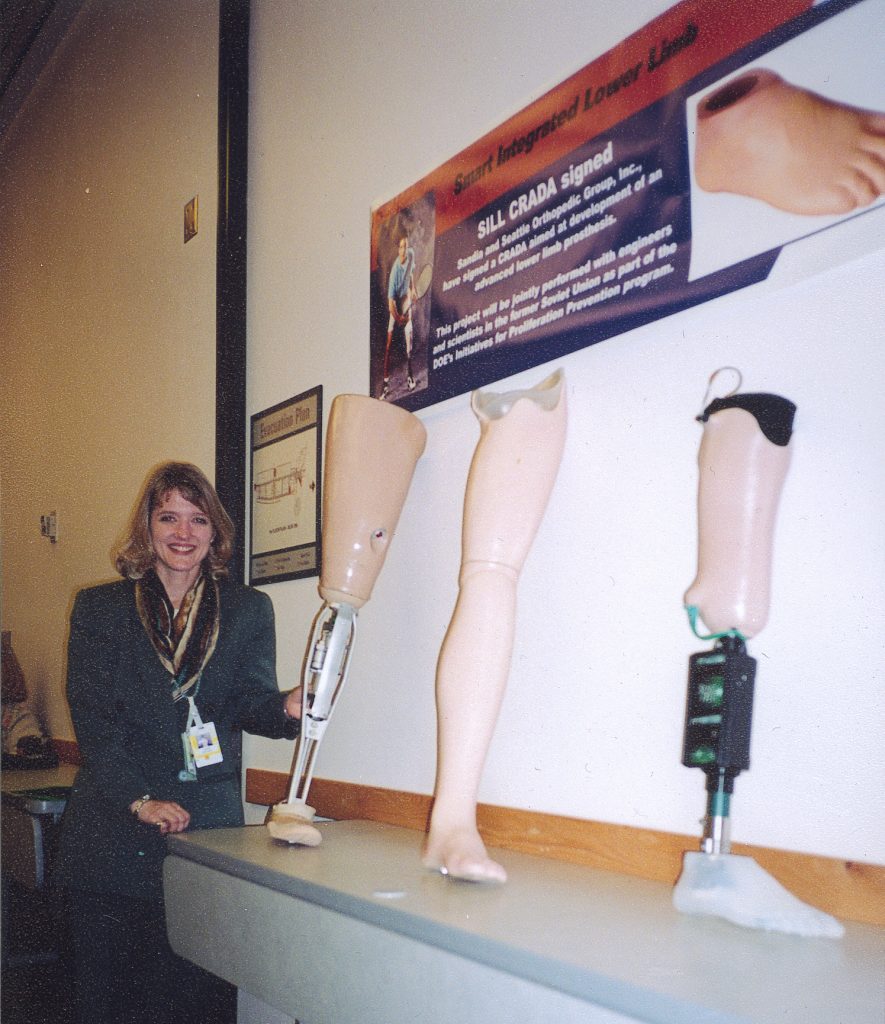
ALBUQUERQUE, N.M. — “Smart” legs — entire smart lower limbs — to replace those amputated from tens of thousands of Americans yearly as a result of auto accidents, diabetes, or other causes are expected to be on the market in two years.
Sensors and chips will be developed by the Department of Energy’s Sandia National Laboratories. Materials work and testing will be performed by, strangely, the Russian nuclear weapons laboratory Chelyabinsk 70. Technical requirements for the limb will be set by the Seattle Orthopedic Group (SOGI).
“This is about making a leg that is more like a missing limb than a collection of components ever can be,” says Diane Hurtado of the Smart Integrated Lower Limb (SILL) project team. “This limb will have a digital control system to make it smart.”
Says Ivan Sabel, president of Hangar, of which SOGI is a division, “This is taking us — an industry that has gone in 30 years from plastic to carbon fibers — to the next generation.”
The advance should enable otherwise competent amputees to maintain active lives rather than be confined to wheelchairs or rest homes.
The leg is intended to simulate a human gait whether on uphill, downhill, or even irregular terrain. To do so, a microprocessor-controlled module implanted in the leg will respond to sensor input from multiple sources. The microprocessor will control hydraulic joints and piezoelectric motors that power the ankle, knee and socket.
The leg socket will also adjust to the changing diameter of an amputated stump over the course of a day, thus reducing sores, improving comfort, and increasing time of use.
Clamoring to walk without falling down
“What amputees are clamoring for is a way to walk without falling down, independent of terrain,” says Sandia researcher Dave Kozlowski, who has designed robotic architectures for surgical operating rooms. “The majority of lower-limb prosthetic devices are based upon passive technologies that require far more energy for amputees to cover the same distance as non-amputees.”
In passive technologies, as the thigh moves forward, inertia opens the knee joint, the artificial shin swings forward, and, when the entire structure locks, the wearer can pass his or her weight over it. The feet are usually not “smart” in adjusting to terrain.
“We intend to develop a much more efficient device, with sensors placed at strategic points along foot and leg, that will enable a more normal and efficient walking gait,” says Kozlowski. A proper limb motion will return energy to the wearer instead of draining it, he says.
One challenge to be addressed is developing a power source light enough for an amputee to feel comfortable carrying it, he says.
Reducing pressure sores
Sandia researcher Mark Vaughn, who also will participate in the project, says another goal is to make a self-adjusting prosthetic socket that will prevent pressure sores caused by the device rubbing against the residual limb. The device will change shape to match the residual limb’s swelling over the course of a day.
“The funding gives us a couple of man-centuries of Russian experimenters to throw at the problem, and it’s right down their alley,” says Vaughn. “They’re mechanical guys. We should get quite a bit of accommodation.”
Reducing nuclear threat
Approximately 120 Russian scientists formerly employed designing nuclear weapons are expected to participate in the project, funded by DOE’s Initiatives for Proliferation Prevention.
Says Sandia manager for international initiatives Bob Huelskamp, “Sandia generally thinks it’s impressive if, say, five of its scientists leave to start an entrepreneurial enterprise. This prosthetics project means that, at a minimum, dozens, and if the project takes off, triple figures of Russians formerly in the weapons-of-mass-destruction business are moving out of that into a humanitarianly useful, and hopefully commercially successful, business venture.”
The Russians bring impressive skills and equipment to the research effort, he says. Says Olen Thompson, “SILL got its start through the integrated efforts of the principal investigators, CRADA specialists, licensing specialists, patent attorneys and the DOE’s Technology Partnership Office in Albuquerque. They had many barriers to overcome but they stayed with it because they believed in the project’s importance.”
DOE is funding the current effort with $1.5 million over two years. SOGI is expected to put up a matching amount in money, goods, and services.
Changing the world
Hurtado takes over project management of Sandia’s prosthetics program from recently retired Sandian Mort Lieberman, who originated it. Two years ago, an agreement he helped create among Sandia, Chelyabinsk 70, a Boston University professor and an American private industry produced an artificial foot that has received impressive reviews. Last year, work was started on an artificial knee.
Lieberman, who spoke at the Sept. 26, 2000, cooperative research and development (CRADA) signing, discussed the change in direction at the Russian nuclear lab and, to some extent, at Sandia (a national security laboratory) initiated by his work. Quoting anthropologist Margaret Mead, he said, “Never doubt that a small group of concerned citizens can change the world.”